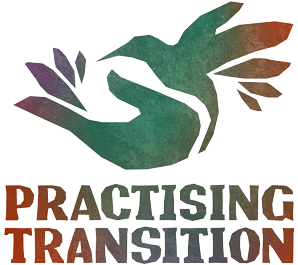What makes a transition group a transition group? The Transition characteristics were developed to answer this question.
People in the Transition movement come together to:
- Engage with the need for change – creating spaces for exploring and engaging with, the complex interconnected challenges of our times (climate change, loss of biodiversity, social injustice and other impacts of the global growth economy).
- Co-create motivating and imaginative narratives and visions – using creative and participatory methods to share stories and possibilities of a healthy, just and resilient future.
- Connect and care for each other – building social cohesion and resilience through practising and celebrating creativity, mutual support, fun and friendship, bridging divides and decreasing polarisation to create caring and equitable communities and cultures.
- Support inner transformations – growing our individual and collective psychological resilience and wellbeing, supporting thriving groups, relationships and conflict transformation, and exploring how our mindsets, attitudes, emotions and worldviews can contribute to or block social change.
- Address injustice – increasing awareness of social justice issues within and beyond our movement and finding ways to decolonise, heal and make reparations for historic and current injustices, becoming good allies to those who have been doing this work for many years.
- Apply Living Systems Design – understanding the principles of living systems and working with whole system design approaches to support the development and emergence of regenerative social systems including: economies, education, health, food/farming and more.
- Take practical actions – designing and implementing practical projects which reduce carbon emissions, address equitable climate change mitigation and adaptation, and increase local resilience e.g. in areas such as food, energy, waste, transport, shelter, habitat protection and healthy ecosystems, mutual aid, community building and disaster relief.
- Contribute to a wellbeing economy – innovating and collaborating to create economic models and opportunities focused on wellbeing and inclusion e.g. new social enterprises, currencies, livelihoods.
- Broaden and deepen participation – convening diverse participation and supporting distributed and engaged deliberation and decision making processes. Valuing and accommodating multiple perspectives and life experiences, including those marginalised by current systems.
- Energise networks and alliances – bringing together and contributing to broad alliances across different levels of scale. Working with local, regional and wider partners, including local government. Making visible, and helping to energise and amplify networks and ecosystems of change that are working towards a common purpose.
The Transition Characteristics can be used in manifold ways. In March 2024 we launched the Practising Transition campaign to help people learn ‘how to do Transition’ whilst being inspired and guided by the characteristics.
